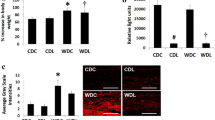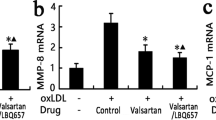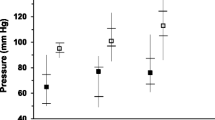Abstract
Dipeptidyl peptidase-4 (DPP-4) inhibitors have potential as a treatment for atherosclerosis. However, it is unclear whether DPP-4 inhibitors stabilize atherosclerotic plaque or alter the composition of complex plaque. Sixteen Watanabe heritable hyperlipidemic rabbits aged 10–12 weeks with atherosclerotic plaque in the brachiocephalic artery detected by iMap™ intravascular ultrasound (IVUS) were divided into a DPP-4 inhibitor group and a control group. Linagliptin was administered to the DPP-4 inhibitor group via nasogastric tube at a dose of 10 mg/kg/day for 16 weeks, and control rabbits received the same volume of 0.5% hydroxyethylcellulose. After evaluation by IVUS at 16 weeks, the brachiocephalic arteries were harvested for pathological examination. IVUS revealed that linagliptin significantly reduced the plaque volume and vessel volume (control group vs. DPP-4 inhibitor group: ∆plaque volume, 1.02 ± 0.96 mm3 vs. − 3.59 ± 0.92 mm3, P = 0.004; ∆vessel volume, − 1.22 ± 2.36 mm3 vs. − 8.66 ± 2.33 mm3, P = 0.04; %change in plaque volume, 6.90 ± 5.62% vs. − 15.06 ± 3.29%, P = 0.005). With regard to plaque composition, linagliptin significantly reduced the volume of fibrotic, lipidic, and necrotic plaque (control group vs. DPP-4 inhibitor group: ∆fibrotic volume, 0.56 ± 1.27 mm3 vs. − 5.57 ± 1.46 mm3, P = 0.04; ∆lipidic volume, 0.24 ± 0.24 mm3 vs. − 0.42 ± 0.16 mm3 P = 0.04; ∆necrotic volume, 0.76 ± 0.54 mm3 vs. − 0.84 ± 0.25 mm3, P = 0.02). Pathological examination did not show any significant differences in the %smooth muscle cell area or %fibrotic area, but infiltration of macrophages into plaque was reduced by linagliptin treatment (%macrophage area: 12.03% ± 1.51% vs. 7.21 ± 1.65%, P < 0.05). These findings indicate that linagliptin inhibited plaque growth and stabilized plaque in Watanabe heritable hyperlipidemic rabbits.



Similar content being viewed by others
References
UK Prospective Diabetes Study (UKPDS) Group (1998) Intensive blood-glucose control with sulphonylureas or insulin compared with conventional treatment and risk of complications in patients with type 2 diabetes (UKPDS 33). Lancet 352(9131):837–853
ACCORD Study Group; ACCORD Eye Study Group, Chew EY, Ambrosius WT, Davis MD, Danis RP, Gangaputra S, Greven CM, Hubbard L, Esser BA, Lovato JF, Perdue LH, Goff DC Jr, Cushman WC, Ginsberg HN, Elam MB, Genuth S, Gerstein HC, Schubart U, Fine LJ (2010) Effects of medical therapies on retinopathy progression in type 2 diabetes. N Engl J Med 363(3):233–244
Nathan DM, Buse JB, Davidson MB, Ferrannini E, Holman RR, Sherwin R, Zinman B (2009) Medical management of hyperglycemia in type 2 diabetes: a consensus algorithm for the initiation and adjustment of therapy: a consensus statement of the American Diabetes Association and the European Association for the Study of Diabetes. Diabetes Care 32(1):193–203
Anderson RJ, Bahn GD, Moritz TE, Kaufman D, Abraira C, Duckworth W; VADT Study Group (2011) Blood pressure and cardiovascular disease risk in the veterans affairs diabetes trial. Diabetes Care 34(1):34–38
Zhong J, Kankanala S, Rajagopalan S (2016) Dipeptidyl peptidase-4 inhibition: insights from the bench and recent clinical studies. Curr Opin Lipidol 27(5):484–492
Stocker R, Keaney JF Jr (2004) Role of oxidative modifications in atherosclerosis. Physiol Rev 84(4):1381–1478
Mizuno Y, Jacob RF, Mason RP (2011) Inflammation and the development of atherosclerosis. J Atheroscler Thromb 18(5):351–358
Kroller-Schon S, Knorr M, Hausding M, Oelze M, Schuff A, Schell R, Sudowe S, Scholz A, Daub S, Karbach S, Kossmann S, Gori T, Wenzel P, Schulz E, Grabbe S, Klein T, Münzel T, Daiber A (2012) Glucose-independent improvement of vascular dysfunction in experimental sepsis by dipeptidyl-peptidase 4 inhibition. Cardiovasc Res 96(1):140–149
Shiomi M, Ito T, Yamada S, Kawashima S, Fan J (2003) Development of an animal model for spontaneous myocardial infarction (WHHLMI rabbit). Arterioscler Thromb Vasc Biol 23(7):1239–1244
Nicholls SJ, Ballantyne CM, Barter PJ, Chapman MJ, Erbel RM, Libby P, Raichlen JS, Uno K, Borgman M, Wolski K, Nissen SE (2011) Effect of two intensive statin regimens on progression of coronary disease. N Engl J Med 365(22):2078–2087
Sathyanarayana S, Carlier S, Li W, Thomas L (2009) Characterisation of atherosclerotic plaque by spectral similarity of radiofrequency intravascular ultrasound signals. EuroIntervention 5(1):133–139
Araki T, Nakamura M, Utsunomiya M, Sugi K (2012) Visualization of coronary plaque in type 2 diabetes mellitus patients using a new 40 MHz intravascular ultrasound imaging system. J Cardiol 59(1):42–49
Garcia-Garcia HM, Gogas BD, Serruys PW, Bruining N (2011) IVUS-based imaging modalities for tissue characterization: similarities and differences. Int J Cardiovasc Imaging 27(2):215–224
Lin QF, Luo YK, Zhao ZW, Cai W, Zhen XC, Chen LL (2013) Atherosclerotic plaque identification by virtual histology intravascular ultrasound in a rabbit abdominal aorta model of vulnerable plaque. Exp Biol Med (Maywood) 238(11):1223–1232
Fukuda K, Iihara K, Maruyama D, Yamada N, Ishibashi-Ueda H (2014) Relationship between carotid artery remodeling and plaque vulnerability with T1-weighted magnetic resonance imaging. J Stroke Cerebrovasc Dis 23(6):1462–1470
Matsubara J, Sugiyama S, Sugamura K, Nakamura T, Fujiwara Y, Akiyama E, Kurokawa H, Nozaki T, Ohba K, Konishi M, Maeda H, Izumiya Y, Kaikita K, Sumida H, Jinnouchi H, Matsui K, Kim-Mitsuyama S, Takeya M, Ogawa H (2012) A dipeptidyl peptidase-4 inhibitor, des-fluoro-sitagliptin, improves endothelial function and reduces atherosclerotic lesion formation in apolipoprotein E-deficient mice. J Am Coll Cardiol 59(3):265–276
Shah Z, Kampfrath T, Deiuliis JA, Zhong J, Pineda C, Ying Z, Xu X, Lu B, Moffatt-Bruce S, Durairaj R, Sun Q, Mihai G, Maiseyeu A, Rajagopalan S (2011) Long-term dipeptidyl-peptidase 4 inhibition reduces atherosclerosis and inflammation via effects on monocyte recruitment and chemotaxis. Circulation 124(21):2338–2349
Iwaya H, Fujii N, Hagio M, Hara H, Ishizuka S (2013) Contribution of dipeptidyl peptidase IV to the severity of dextran sulfate sodium-induced colitis in the early phase. Biosci Biotechnol Biochem 77(7):1461–1466
Schade J, Schmiedl A, Kehlen A, Veres TZ, Stephan M, Pabst R, von Horsten S (2009) Airway-specific recruitment of T cells is reduced in a CD26-deficient F344 rat substrain. Clin Exp Immunol 158(1):133–142
Busso N, Wagtmann N, Herling C, Chobaz-Peclat V, Bischof-Delaloye A, So A, Grouzmann E (2005) Circulating CD26 is negatively associated with inflammation in human and experimental arthritis. Am J Pathol 166(2):433–442
Steven S, Hausding M, Kroller-Schon S, Mader M, Mikhed Y, Stamm P, Zinssius E, Pfeffer A, Welschof P, Agdauletova S, Sudowe S, Li H, Oelze M, Schulz E, Klein T, Munzel T, Daiber A (2015) Gliptin and GLP-1 analog treatment improves survival and vascular inflammation/dysfunction in animals with lipopolysaccharide-induced endotoxemia. Basic Res Cardiol 110(2):6
Sudo M, Li Y, Hiro T, Takayama T, Mitsumata M, Shiomi M, Sugitani M, Matsumoto T, Hao H, Hirayama A (2017) Inhibition of plaque progression and promotion of plaque stability by glucagon-like peptide-1 receptor agonist: serial in vivo findings from iMap-IVUS in Watanabe heritable hyperlipidemic rabbits. Atherosclerosis 265:283–291
Acknowledgements
We thank the staff at the Nihon University Medical Research Support Center for their assistance with animal management. We offer special thanks to Rie Takahashi and Yoshiki Taniguchi for their excellent technical assistance.
Author information
Authors and Affiliations
Corresponding author
Ethics declarations
Conflict of interest
The authors declare that they have no conflict of interest.
Statement on the welfare of animals
The experimental protocol was approved by the Animal Care and Use Committee of Nihon University (No. AP15M012). All procedures performed in studies involving animals were in accordance with the ethical standards of the institution.
Additional information
Publisher's Note
Springer Nature remains neutral with regard to jurisdictional claims in published maps and institutional affiliations.
Rights and permissions
About this article
Cite this article
Kurosawa, T., Li, Y., Sudo, M. et al. Effect of the dipeptidyl peptidase-4 inhibitor linagliptin on atherosclerotic lesions in Watanabe heritable hyperlipidemic rabbits: iMap-IVUS and pathological analysis. Heart Vessels 36, 127–135 (2021). https://doi.org/10.1007/s00380-020-01689-8
Received:
Accepted:
Published:
Issue Date:
DOI: https://doi.org/10.1007/s00380-020-01689-8




